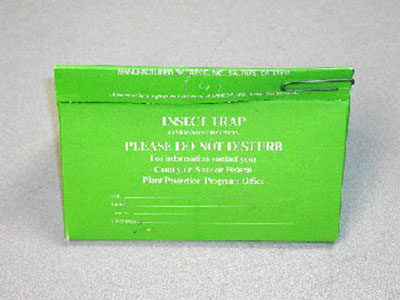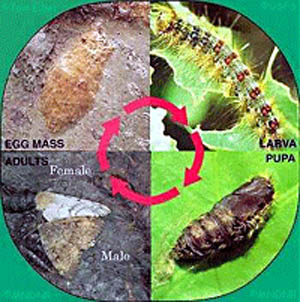Issue 9, June 19, 2009
Invasive Species Spotlight--Gypsy Moth
The purple traps seen hanging in trees have been a topic of conversation lately, but I’ve also received a few calls about these small traps on trees and posts as well.

Gyspy moth trap.
Gypsy moths are among some of the most destructive forest pests in the United States ... did you know they were brought here intentionally? They were originally intended to be used to increase disease resistance in hybridized silk spinning caterpillars, but the gypsy moth escaped the industry and became established in natural areas. From there it has slowly spread throughout the northeastern states south to Virginia and west to the Great Lakes Region; it is beginning to establish itself in Illinois (see map).

Gypsy moth life cycle
Mature females lay egg masses in mid to late summer. Larvae emerges from the mass in the following spring (hatching generally occurs when most hardwood trees are starting to bud). Each larva can be from one to two inches long with hairs running down its entire body. They are grayish in color with five pairs of blue spots and six pairs of red spots on their body with yellow markings on their heads. They transform into the pupa stage in mid summer and emerge as adults usually beginning in July. Male moths are light tan to dark brown with wavy bands and have a wingspan of about an inch. Females are almost all white with faint darker wavy bands on the forewings and have a wingspan up to two inches. Female gypsy moths do not fly and will typically lay their eggs near areas where they were feeding (including picnic tables, firewood, grills, and even cars). When these items are moved, these "hitchhikers" move with them!

Severe defoliation caused by gypsy moth.
Gypsy moth larvae are known as severe tree defoliators and can be a tremendous problem for forest land owners and managers. Oaks (Quercus spp.) are their preferred meal but they will feed on over 500 shrubs and trees. When large populations build up, 1000 egg masses per hectare, the damage can become quite extensive. This could lead to entire forests being stripped of their foliage. Healthy trees can usually withstand the loss of one flush of leaves, but if it happens continuously throughout the year in consecutive years it will mean almost certain failure; especially when coupled with other insect, disease, and environmental conditions.
The gypsy moth trapping program in Illinois is a cooperative effort between the Illinois Department of Agriculture and USDA-APHIS-PPQ. The goal of this survey is to determine the spread and dispersal of the gypsy moth in Illinois. Illinois is considered a transition state and is part of the Slow the Spread (STS) program. STS is one of the largest monitoring and action programs in the nation targeting the Gypsy moth. Illinois Department of Agriculture has placed ~6,500 traps in the STS area (northeastern Illinois). USDA-APHIS-PPQ heads the Detection Trapping and has placed ~6,500 traps in 84 central and southern Illinois counties. This program monitors populations by using pheromone traps to detect the spread of the insects to notify interested parties and to establish action plans. Scientists have begun to capitalize on natural enemies of the Gypsy Moth as a way to help keep their populations under control. Several of these natural enemies include bacteria such as Bacillus thuringiensis (Bt), viruses such as Gypchek, and predatory insects such as parasitic wasps.
For more information, stop by the Illinois CAPS blog for all the latest news on invasive pests in Illinois.--Kelly Estes
Author:
Kelly Estes